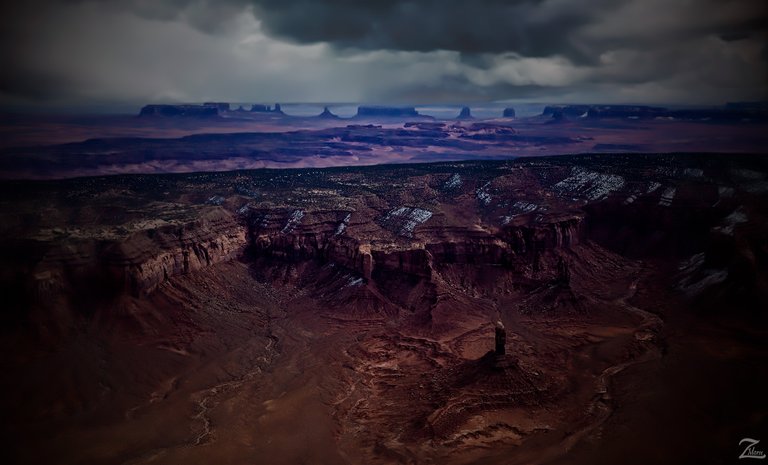Taken late in the afternoon while flying and skirting around a storm in the Four Corners area in Utah along the Arizona border, this shows the mysterious and otherworldly landscape of Monument Valley. This ancient landscape is located on the First Nations Navajo (Diné) Tribal Reservation.
In the foreground is Hoskinnini Mesa with a lone towering Hoodoo formation standing strong against the elements in the bottom of this image. To the right of the Hoodoo is Copper Creek. In the background is the mystical and spiritually inspiring Monument Valley, (“Tsé Biiʼ Ndzisgaii”, for "valley of the rocks").
Hoskinnini Mesa is located west of Monument Valley near Kayenta. It was named after the much respected Diné leader, Hashké neiní, who was born in the Monument Valley area.Hashké neiní (Diné for" The Angry One" ) is known for his resistance to being forcibly removed during the unfortunate events of 1864 when Kit Carson begin his cruel campaign, now referred to as the “Long Walk”.
Union Army soldiers removed the Diné from their traditional ancestral homelands in the Four Corners Region and made them walk over 300 miles to a new reservation established by the Federal Government in eastern New Mexico known as Bosque Redondo.
The march was one that was very difficult and pushed many Diné to their breaking point, even death. The distance itself was cruel, and the fact that they did not receive any aid from the soldiers was devastating. Very few Diné were in prime condition to trek 300 miles, and many began the walk exhausted and malnourished while others were not properly clothed nor in the least prepared for such a long and harsh journey.
At least 200 died during the 18-day, 300-mile (500-km) trek.Hashké neiní and his band evaded capture by the soldiers and lived for four years in the Navajo Mountain region in Utah. He became known as the "Emperor" of Monument Valley. While in hiding, Hashké neiní discovered a silver mine.
This discovery helped he and his family to become wealthy and they made ornaments out of the silver from the mine. Allegedly he was the first Diné Tribesman to own a turquoise necklace.In 1868 after the Diné were finally released and allowed to return to their ancestral homelands, Hashké neiní became known for his generosity to those who had survived their internment at Bosque Redondo.
He died in 1912 in Monument Valley.I like this image of Hoskinnini Mesa because of that lonely Hoodoo tower in the lower part of the picture. I like to imagine this as a beautiful symbol of Hashké neiní, standing strong and proud, surviving through time, shaped by the elements.
From "Where Eagles Fly - The American Wilderness Expedition" my personal project of exploration in the North American Wilderness.

Awesome picture...so was the story...